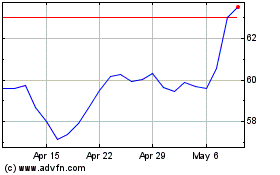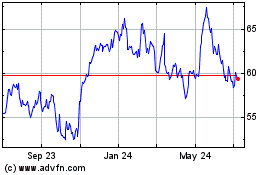By Nat Ives
The lagers that long symbolized beer in the U.S. --
easy-drinking brews whose ad campaigns entered pop culture with
catchphrases like "Whassup?" -- are losing market share.
Traditional domestic beer remains the largest category of
alcohol in the U.S., but it fell to 17.7% of in-store sales in the
52 weeks through Sept. 7 from 22.3% four years earlier, according
to market-research firm Nielsen.
Drinkers are gravitating instead to craft brews, liquor and,
most recently, seltzer with alcohol in it. Some are even testing
the market for hard kombucha, a version of the fermented tea drink
that has higher alcohol content than the trace amount in
traditional kombucha.
And mass-media advertising, which once would have been Big
Beer's most powerful defense against the competition, is steadily
fading.
So what is the company behind the "King of Beers" doing to keep
up with all these changes?
Although Anheuser-Busch InBev SA is known for its flagship
Budweiser brand, its portfolio includes brews made around the
world, and has expanded to include both craft beers and hard
seltzer. It devoted one of its Super Bowl ad slots this year to a
pair of mermaids who pitched Bon & Viv Spiked Seltzer by
talking up "fruit botanicals" and zero sugar. And yes, it now sells
Kombrewcha, a carbonated tea with 4.4% alcohol by volume.
At the same time, Anheuser-Busch InBev is battling traditional
beer rivals with a U.S. ad campaign pointing out that Coors Light
and Miller Lite use corn syrup in their brewing processes while Bud
Light does not. (Never mind that corn syrup is only used in the
fermentation stage of brewing and never makes it into the
competitors' products, a point that MillerCoors LLC stressed in a
false-advertising lawsuit. A judge temporarily barred Bud Light
from running some of the campaign's ads or using the words "no corn
syrup" on its packaging, but the court fight continues.)
Last week Anheuser-Busch InBev announced plans for a Bud
Light-branded hard seltzer, but cut its full-year guidance after a
disappointing quarterly performance in the U.S. and China.
In an interview with The Wall Street Journal, Anheuser-Busch
InBev's chief marketing officer, Pedro Earp, discussed how the
brewer is trying to navigate these challenging conditions.
Here's one hint: When the company tapped him last year to take
over the top marketing job, it let him continue as the head of the
company's innovation unit, ZX Ventures, which aims to meet and
anticipate consumers' needs with new products and services.
Here are edited excerpts of the conversation.
Marketing as entertainment
WSJ: Traditional beer has been losing ground for years. What's
going wrong?
MR. EARP: We are a global company, and there are a lot of
tailwinds in emerging markets, such as Colombia and China -- but
more-mature markets are under pressure. The choices that consumers
can make are diversifying. So we really have to diversify and offer
what consumers are looking for. That's going to be a tool to
reignite growth in the U.S. market.
WSJ: Are beer drinkers changing?
MR. EARP: We see consumers trading up and going for
more-expensive products. We've been focusing on super-premium
brands and craft. That's one angle.
The second one is health and wellness. Beer can play very well
in that space because it's made of wholesome ingredients. It's
relatively low in carbs and calories despite the perception that
some people have.
WSJ: What's your plan for improving your marketing in
particular, if that can be separated from diversifying your
products?
MR. EARP: Portfolio is key. If you think about 10, 20 years ago,
you could create an average product or a product that didn't have a
lot of functional difference and you could really use mass
advertising to drive emotional differentiation. The world has
completely changed. Consumers are much more savvy about what's a
great product or not. So true product differentiation became a much
more important factor than emotional differentiation.
Once you have the right products, the big shift in marketing is
from interruption to entertaining. If you look at Netflix or
WhatsApp, a lot of platforms are ad-free. The future of marketing
is one where brands will need to earn their space and entertain
consumers.
And then you need to understand your consumers much better,
their passion points and needs. Data makes a massive difference. So
we have a massive area here to do that.
WSJ: How have you tried to entertain consumers?
MR. EARP: We have many examples. Country music is a massive
passion point in Brazil.We sponsored a whole show about
up-and-coming talent, and our Brahma beer is integrated on screen.
In Mexico, we created a brand integration for Corona in three
Netflix original programs about football teams.
WSJ: Is legal cannabis a threat to alcohol sales?
MR. EARP: In today's world we have to be to be paranoid. Our
mission as a company is to bring people together, and over time
there will be other products that try to fulfill that role. In the
U.S. cannabis is still federally illegal, so we don't anticipate
doing anything in the space. In Canada, where it's legal, we
decided to go there and do our research, because we have to
understand the competitive landscape and what could be the
impact.
It's very early days to come to a conclusion. Edibles and
drinkables are still not even in the market in Canada, and that's
the space we're most interested in, especially beverages.
WSJ: You're one of the big players in the growing hard-seltzer
market, but competitors like Mark Anthony Brands' White Claw are
outselling your Bon & Viv, and doing well among both men and
women.
MR. EARP: It's something that we have to do a better job with.
The challenge with the need to have a much broader portfolio is,
how do you focus on the things that are really going to grow? How
do you give what consumers want, but at the same time you don't
spread yourself too thin?
We are not 100% happy with where we are in the seltzer category
given the performance. But so far we have two products: Bon &
Viv, which is more of a premium product targeting more nonbeer
drinkers, and we just launched Natty Light seltzer, targeting more
beer drinkers at a lower price, and we are very happy and surprised
with the results.
WSJ: Natty Light seltzer has higher alcohol than the
leaders.
MR. EARP: Six percent, yeah. But we talked about health and
wellness; hard seltzers are relatively low in alcohol, they have
low calories, they are low in carbs -- so we believe in the
underlying trends.
Everything that breeds excitement and addresses a consumer need
is good for the industry. In the U.S., hard seltzer is categorized
as beer because of the malt-beverage base. And hard seltzer
actually brought growth back to the beer category.
Focus on innovation
WSJ: How does ZX Ventures work?
MR. EARP: We've been accelerating a lot of innovation since
2010, 2011. But it was more incremental than exponential, and the
world is evolving at an exponential speed. So in 2015, we decided
to try something a little bit different. Instead of having 100% of
our innovation run from within the core business, and in a way
competing for financial resources and attention with the big
businesses, we decided to set up ZX, which is almost an independent
organization with dedicated resources and dedicated people to drive
innovation at an exponential rate without distracting from the
focus on the big business.
WSJ: What's something that's come out of ZX?
MR. EARP: We've been accelerating a lot of innovation since
2010, 2011. But it was more incremental than exponential, and the
world is evolving at an exponential speed. So in 2015, we decided
to try something a little bit different. Craft beer has been
growing in the U.S. since the '80s. It was very hard for us to put
focus on craft and put focus on scaling some brands that we had at
the same time, and we lagged the evolution of the industry.
When we set up ZX we had two opportunities: First, we could
catch up in terms of our portfolio. And second, craft was actually
still very underdeveloped in a lot of the emerging world. We said,
we know that the trends are very similar to the developed markets
-- why don't we go there and drive the craft revolution in a lot of
these emerging markets instead of lagging behind? And that's what
we did.
Then we created an area here called brand experience. We're in
the mission of bringing people together, and probably there's
nothing that brings people more together than a bar, a retail
location. In the past two years, we have opened more than 500 beer
bars with our craft brands all over the world. These bars became a
marketing channel that makes money.
And we have something called our Explore Fund, which is an
investment fund taking a look at what's next in beverages. We ended
up acquiring Kombrewcha. We have Hiball, which is good-for-you
energy drinks.
WSJ: Did you ever anticipate something like hard kombucha coming
along?
MR. EARP: Hard kombucha was one of the first investments that we
made here at ZX.
The trick to stay ahead of the curve is to identify consumer
trends very early. And it's going to be more of an open innovation
system, I think, than in the past.
In the past, a lot of companies tried to innovate all by
themselves. It's much better for you to work as a platform. There
are thousands of craft brewers out there thinking 24/7 about beer
and about what's next. We believe a great model for future
innovations is a model of partnership. Kombrewcha was one of
them.
WSJ: Did anything from ZX fail to take off?
MR. EARP: We had a home-brewing business. One of the big hurdles
in home brewing is to wait for six or seven days for the
fermentation of the beer. We created a system so you could have
your customized beer in hours or minutes instead of days.
We were all excited about it. And at the end it was a complete,
complete flop, because there were kind of two types of consumers --
the ones that love the crafting of the beer and the hobby, and the
ones that like convenience...
WSJ:...And just wanted to drink out of the bottle.
MR. EARP: Exactly. Nobody wanted the in-between solution. This
is just one example. But in ZX, like in every innovation
organization, you have many more failures than successes. Usually
our failures are cheap and fast, and I think that's the trick.
WSJ: How do you find out what consumers want, or what they're
going to want next?
MR. EARP: We have a huge amount of trends research. There is
this phrase that the future is already here, but it's not evenly
distributed. To give you an example, our innovation team just came
back from two weeks in Japan. Japan is very forward in terms of
innovation. They have beer with collagen there.
WSJ: Why?
MR. EARP: Because it's good for the bones, it's good for your
skin. Aging is happening all over the globe, but in Japan it's
phenomenal.
You try to take a look at the signals that are popping up here
and there that are a predictor of what is going to be big in the
future.
Mr. Ives is the editor of CMO Today at The Wall Street Journal.
Email nat.ives@wsj.com.
(END) Dow Jones Newswires
October 27, 2019 22:19 ET (02:19 GMT)
Copyright (c) 2019 Dow Jones & Company, Inc.
Anheuser Busch Inbev SA NV (NYSE:BUD)
Historical Stock Chart
From Mar 2024 to Apr 2024

Anheuser Busch Inbev SA NV (NYSE:BUD)
Historical Stock Chart
From Apr 2023 to Apr 2024
